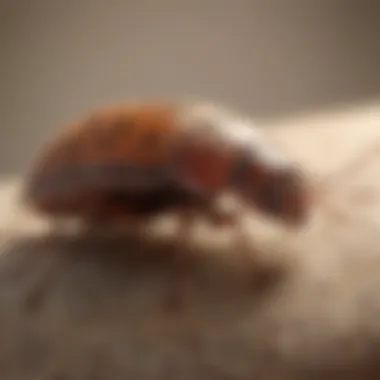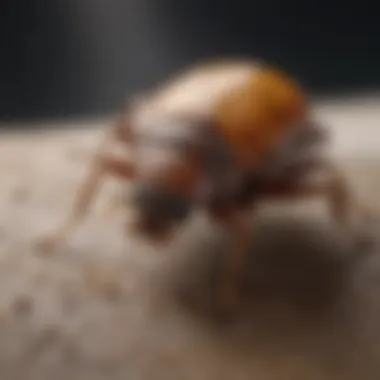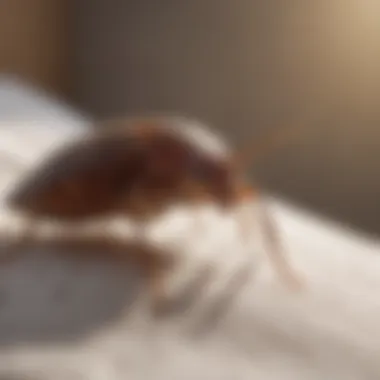Unveiling the Effectiveness of Bed Bug Foggers: A Comprehensive Study


Preventive Pest Control Strategies
When it comes to effective pest control, implementing preventive measures is paramount. Starting with house exterior protection, sealing cracks and crevices is a crucial step in deterring pests from entering your home. Clearing debris from around the house eliminates potential hiding spots for pests, ensuring a pest-free environment. Additionally, taking proactive steps to prevent pests from entering, such as installing door sweeps and inspecting for gaps, can significantly decrease the likelihood of infestations. In terms of yard maintenance, implementing essential yard care routines like regular mowing and trimming shrubs reduces pest harborage areas. Employing methods such as removing standing water and maintaining a clutter-free yard are key strategies for keeping your outdoor space pest-free. Indoor cleanliness is pivotal in pest prevention, where expert cleaning tips and techniques can help eliminate potential food and water sources for pests. Maintaining a pest-resistant indoor environment involves proper food storage, regular vacuuming, and minimizing clutter. Efficient waste disposal methods are crucial in minimizing pest attraction. Proper garbage disposal not only keeps pests like rodents and cockroaches at bay but also helps in maintaining overall hygiene. In addition to these methods, exploring innovative ways to safeguard your home, such as using plant-based repellents and electronic deterrents, can bolster your pest prevention efforts.
Introduction
In the realm of pest control, the effectiveness of bed bug foggers stands as a crucial topic deserving comprehensive analysis. Bed bug infestations can be incredibly challenging to tackle, and foggers present themselves as a potential solution. This article aims to delve deep into the efficacy of bed bug foggers, shedding light on various factors that dictate their success or limitations. Being able to understand the nuances of bed bug foggers can empower individuals facing such infestations to make informed decisions regarding their pest control strategies.
Overview of Bed Bug Foggers
Understanding the concept of bed bug foggers
The notion of bed bug foggers revolves around the dispersion of insecticides in a mist or fog form within the infested area. This method aims to reach hidden spaces where bed bugs may reside, effectively targeting the pests and their eggs. Understanding the concept of bed bug foggers is pivotal as it underlines the fundamental approach of combating bed bugs through a process that can penetrate hard-to-reach areas, potentially eradicating the infestation at its core. The ability of foggers to access crevices and areas where bed bugs hide makes them a popular choice for many individuals seeking a solution to persistent infestations.
Common types of foggers available in the market
When exploring the market for bed bug foggers, one encounters various types designed to cater to different needs and preferences. There are foggers that release pyrethrin-based insecticides, while others rely on synthetic chemicals for pest control. Understanding the common types of foggers available in the market provides consumers with a spectrum of choices, each with its unique characteristics and effectiveness levels. This variety allows individuals to select a fogger that aligns best with their specific requirements, whether focusing on natural ingredients, quick results, or long-lasting effects. The diversity in available foggers offers users the flexibility to tailor their pest control approach according to their preferences and circumstances.
Scope of the Article
Defining the objectives of analyzing bed bug foggers
By encompassing the objectives of analyzing bed bug foggers, this article aims to offer a comprehensive insight into the efficacy and practicality of utilizing such methods. The core focus lies in evaluating the benefits and potential drawbacks of bed bug foggers, guiding readers towards a nuanced understanding of these pest control devices. Clear objectives help set the groundwork for a thorough exploration of bed bug foggers, enabling readers to grasp the nuances of this pest control technique and its implications on successfully combating bed bug infestations.
Factors Influencing Effectiveness


In the realm of bed bug elimination, understanding the Factors Influencing Effectiveness holds paramount significance. These factors serve as the bedrock for successful eradication of bed bugs using foggers. By delving into the intricacies of these factors, we can unlock the optimal performance of foggers in combatting infestations. From meticulous preparation techniques to environmental considerations, each element plays a crucial role in enhancing the efficacy of bed bug foggers. Through a thorough analysis of these Factors Influencing Effectiveness, individuals can streamline their approach towards eradicating bed bugs effectively and efficiently.
Preparation Before Fogging
Importance of preparing the infested area
The meticulous preparation of the infested area before fogging is a critical step in the battle against bed bugs. This preparatory phase sets the foundation for the successful application of foggers by ensuring that the environment is conducive to maximum efficacy. By decluttering and cleaning the infested area, individuals create an optimal setting for the foggers to penetrate and target the bed bugs effectively. This step not only enhances the reach of the foggers but also increases the chances of eliminating bed bugs comprehensively. The importance of preparing the infested area cannot be overstated, as it directly influences the success rate of the fogging procedure.
Steps to take before using foggers
Prior to deploying foggers, specific steps must be taken to amplify their effectiveness. These preparatory measures include sealing off cracks and crevices, covering food and utensils, and evacuating pets and people from the treated area. Each of these steps serves a dual purpose: protecting the inhabitants of the space and enhancing the potency of the foggers. By meticulously adhering to these preparatory steps, individuals can ensure that the foggers operate optimally and achieve the desired results in combating the bed bug infestation.
Proper Application Techniques
Guidelines for effectively using foggers
Employing the right techniques when using foggers is essential for maximizing their efficiency. Guidelines such as reading and following the manufacturer's instructions, shaking the canister well before application, and ensuring even distribution of the fogger's contents can significantly impact the outcome of the treatment. By adhering to these guidelines, individuals can give their fogging endeavors the best chance of success, leading to a more effective eradication of bed bugs.
Mistakes to avoid during application
Equally important is understanding the common mistakes to avoid during the application of foggers. These include overusing foggers, neglecting to cover or remove items that can be damaged by the chemicals, and failing to ventilate the treated area adequately post-fogging. By steering clear of these pitfalls, individuals can prevent setbacks in the fogging process and achieve optimal results in their fight against bed bugs.
Environmental Factors
Impact of temperature and humidity on fogger effectiveness


Environmental conditions like temperature and humidity play a pivotal role in determining the effectiveness of foggers in combating bed bugs. Optimal temperature levels within the treated area can enhance the performance of the chemicals released by the foggers, ensuring a more thorough extermination process. Likewise, maintaining adequate humidity levels can facilitate the dispersion and penetration of the fogging agents, reaching hidden bed bug populations and eradicating them effectively. Understanding and controlling these environmental factors are instrumental in optimizing the results obtained from bed bug foggers.
Potential Drawbacks of Bed Bug Foggers
In the realm of pest control, particularly concerning bed bug infestations, understanding the potential drawbacks of bed bug foggers is paramount. While foggers can be effective in treating bed bugs, there are specific elements and considerations that individuals must be aware of to make informed decisions. By delving into the drawbacks of bed bug foggers, this article aims to provide a holistic view of their efficacy and limitations.
Residual Effects
Understanding residual chemicals left by foggers
Discussing the residual effects of chemicals left behind by foggers is crucial when considering the overall impact of using such products. Understanding how these residual chemicals interact with the environment and potential health risks is essential. This specific aspect sheds light on the long-lasting effects of foggers and how they contribute to the overall effectiveness in eradicating bed bugs. By highlighting the persistence of these chemicals post-fogging, readers gain insights into the longevity of the treatment and its efficacy in preventing re-infestation. In evaluating the residual effects, it is crucial to mention the key characteristics of these chemicals, such as their ability to penetrate crevices and remain active for extended periods. This characteristic makes them a popular choice as it ensures comprehensive coverage in treating bed bug infestations. However, the unique feature of residual chemicals also introduces some disadvantages, including potential risks of exposure to toxic substances and environmental concerns. Balancing these advantages and disadvantages is essential for readers to make informed decisions regarding the use of foggers.
Health Concerns
Potential risks associated with fogger chemicals
Exploring the potential health risks associated with fogger chemicals is vital for a comprehensive understanding of the topic. Delving into these risks provides valuable insights into the impact of exposure to such chemicals on human health and well-being. By highlighting the key characteristics of these risks, such as respiratory issues, skin irritations, and allergic reactions, readers can assess the potential drawbacks of using foggers in their homes. Understanding why these health concerns are a crucial consideration in pest control practices helps readers weigh the benefits and risks of fogger treatments. Describing the unique features of these risks, including their acute or chronic nature, allows readers to grasp the severity of possible health implications. Additionally, outlining the advantages and disadvantages of health concerns associated with fogger chemicals enables readers to make informed choices regarding the safety of their households. By addressing these health considerations, individuals can prioritize their well-being while effectively combatting bed bug infestations.
Best Practices for Optimal Results
In the realm of combating bed bug infestations, adhering to best practices for optimal results is of paramount importance. These practices serve as the cornerstone for achieving effectiveness when utilizing bed bug foggers. By meticulously following these guidelines, individuals can boost the likelihood of eradicating bed bugs successfully from their living spaces. Varying from post-fogging precautions to ongoing monitoring, each practice plays a crucial role in the overall efficacy of the fogging process.
Post-Fogging Precautions
Safety measures after fogging: After the fogging process, it is vital to implement comprehensive safety measures to safeguard both individuals and pets from exposure to residual chemicals. This entails ventilating the treated area thoroughly to dissipate any lingering fumes and minimizing direct contact with surfaces that have been treated. One key characteristic of safety measures after fogging is their efficacy in reducing the potential health risks associated with prolonged exposure to chemical residues. While these measures may require diligence, they are a popular choice due to their ability to ensure a safe and healthy environment post-fogging. The unique feature of safety measures after fogging lies in their proactive nature, offering a protective shield against any adverse effects that could arise from exposure to fogger chemicals, making them a highly beneficial aspect of this article.


Cleaning tips post-fogging: Another essential practice is adhering to specific cleaning tips after fogging. This involves thoroughly cleaning and sanitizing the treated area to remove any residual chemicals and debris left behind post-fogging. A key characteristic of these cleaning tips is their ability to eliminate any traces of chemicals that could potentially pose health risks. Their popularity stems from the fact that clean-up procedures are integral in ensuring a safe and habitable environment following the fogging process. The unique feature of cleaning tips post-fogging lies in their ability to enhance the overall effectiveness of the treatment by eradicating any remaining bed bugs or their eggs. While these tips demand attention to detail, their advantages in promoting a healthy living space outweigh any potential disadvantages, making them a valuable inclusion in this article.
Monitoring and Follow-Up
Importance of monitoring for re-infestation: Monitoring for re-infestation post-fogging is a critical aspect that contributes significantly to the long-term success of bed bug eradication. By keeping a vigilant eye on potential signs of bed bug resurgence, individuals can proactively address any new infestations swiftly. The key characteristic of monitoring for re-infestation lies in its ability to detect early warning signs of bed bugs, allowing for prompt intervention before the issue escalates. This practice is a popular choice as it provides reassurance and peace of mind to individuals who seek to maintain a bed bug-free environment. The unique feature of monitoring for re-infestation is its proactive approach, offering a preemptive strategy against potential bed bug challenges, making it highly advantageous in the context of this article.
Steps for ongoing bed bug prevention: Implementing continuous steps for bed bug prevention post-fogging is crucial in sustaining a bed bug-free environment in the long run. These steps may include routine inspections, sealing cracks and crevices, and minimizing clutter to eliminate potential bed bug hiding spots. A key characteristic of these prevention measures is their effectiveness in deterring bed bugs from re-infesting treated areas, thus fortifying the success of the fogging treatment. Their popularity stems from the fact that ongoing prevention measures are vital in maintaining a pest-free space over time. The unique feature of steps for ongoing bed bug prevention lies in their proactive nature, offering a shield against future infestations and ensuring prolonged efficacy of the fogging treatment. While these measures require consistency and dedication, their advantages in long-term bed bug management make them a valuable asset to this article.
Conclusion
In this final section of the comprehensive analysis on the effectiveness of bed bug foggers, it is crucial to summarize the key takeaways and insights garnered throughout the entire discourse. The examination of bed bug foggers as a solution for combating infestations has shed light on various critical aspects that homeowners need to consider when opting for this method. Understanding the factors influencing fogger effectiveness, potential drawbacks, and best practices are essential in ensuring successful pest control measures.
Summary of Key Findings
Recap of Factors Impacting Fogger Effectiveness
Delving into the recap of factors that influence the effectiveness of bed bug foggers has revealed the significance of proper preparation before fogging. By emphasizing the importance of preparing the infested area adequately and following precise steps prior to fogger application, users can maximize the efficiency of the treatment. Additionally, highlighting the proper application techniques stresses the need for adherence to guidelines and the avoidance of common mistakes during application.
The consideration of environmental factors, such as temperature and humidity, further emphasizes the impact on fogger effectiveness. Understanding how these variables can enhance or hinder the treatment process helps users optimize their outcomes. By acknowledging these factors, individuals can take proactive measures to create an environment conducive to successful bed bug elimination.
Recommendations for Overcoming Drawbacks
Addressing potential drawbacks associated with bed bug foggers is vital in ensuring comprehensive pest control strategies. Exploring the residual effects of fogger chemicals underscores the importance of understanding and managing any lingering substances post-treatment. By being aware of these effects, users can take necessary precautions to mitigate risks and ensure a safe living environment.
Considering health concerns related to fogger chemicals highlights the importance of safety measures and proper use. Recognizing the potential risks allows individuals to make informed decisions and safeguard their well-being during the pest eradication process. By prioritizing health and safety, users can effectively utilize foggers while minimizing associated risks.
Final Thoughts
In the culminating section of this analysis, it is essential to provide closing remarks on the efficacy of bed bug foggers as a pest control solution. Emphasizing the importance of continuous monitoring and follow-up after fogging is crucial in preventing re-infestations. By implementing routine checks and preventive measures, homeowners can maintain a bed bug-free environment and safeguard their living spaces.
Ensuring meticulous post-fogging precautions and adhering to recommended cleaning tips reinforces the efficacy of bed bug foggers. By incorporating these practices into routine pest control efforts, individuals can optimize results and reduce the likelihood of recurring infestations. Ultimately, by staying vigilant and proactive in bug prevention measures, homeowners can enjoy a pest-free home environment for the long term.



